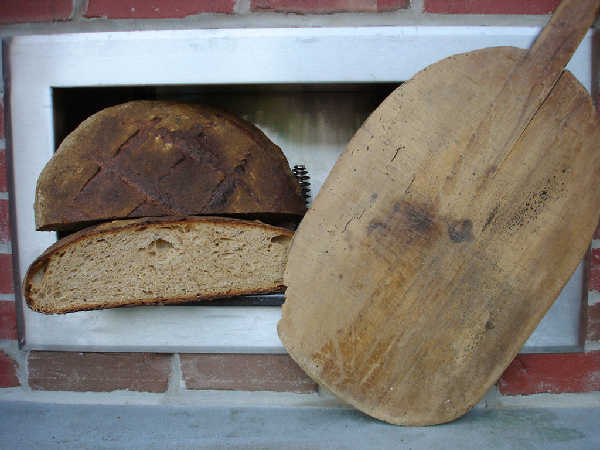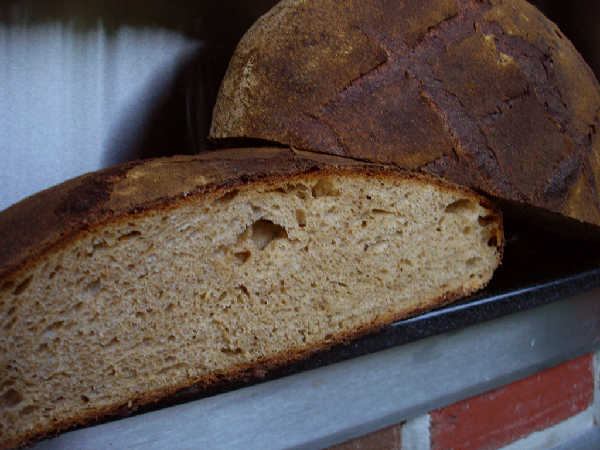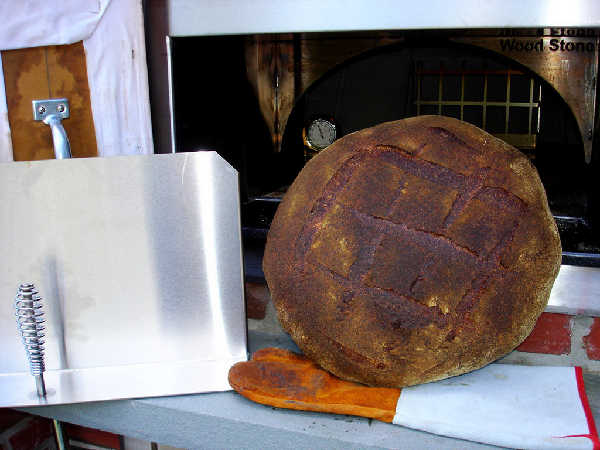
Another Miche



This miche is a lower hydration version of Miche(2) blogged a while back. I accidentally mixed in an entire levain that had been made larger than what I had intended in this recipe originally. I wanted to have an inoculation or percentage of fermented flour to total flour of 15%, similar to Hamelman's VT Sourdough, but I ended up with about 22%. I therefore had a problem with excess acid breaking down the gluten, which made the boule hard to shape and ended up making this a slightly denser miche than I've accomplished before. It's still a good chunk of bread. I baked it in my new brick oven from Woodstone. I managed to get the temperature much more reasonable, and came out with a nice crust and avoided the scorching I'd had in the first few attempts with this new oven, as I learned to manage the heat and the steam in a brick oven.
I have some photos of the process and an html spreadsheet, as well as the Excel spreadsheet that includes the recipe and a model to estimate the bulk fermentation and final proof times.
Miche(3) Recipe
Levain
- 15g 90% hydration white flour storage starter (use any storage starter)
- 90g Wheat Montana AP (or any other strong white flour)
- 105g whole spelt
- 89g Golden Buffalo from Heartland Mills (Use any high extraction wheat flour or substitute white flour here)
- 145g water
Overnight Soak
- 81g whole rye
- 54g whle spelt
- 108g Wheat Montana Bronze Chief (or other red whole wheat flour)
- 338g Golden Buffalo from Heartland Mills (or other high extraction red wheat flour)
- 257g Sifted White Wheat Flour from Homestead Grist Mill (or other high extraction white wheat flour)
- 680g water
- 12g malt syrup
Dough
- Levain from above
- Soak from above
- 219g Wheat Montana AP (or other strong white flour)
- 139g water
- 26g salt
Mix Levain and Soak
The night before you plan to bake, mix the levain ingredients, knead minimally, and let it rise overnight, preferably until it has somewhat more than doubled but not much more, about 10 hours. You can also mix it earlier in the day, let it rise by double and refrigerate it. Also mix the soak ingredients, knead minimally just to mix the ingredients, the water, and the malt syrup. Refrigerate the soak overnight.
Mix and Knead Dough
Mix the additional white flour and water and knead minimally into a small dough. Spread the soak out like a pizza. Spread the white flour over the soak, roll up, and knead lightly to mix. Spread the dough out again and spread the levain over the dough, roll up, and knead the dough until well mixed. I have used a technique described by Glezer in Artisan Baking that works very well to mix the dough. It involves working down the dough squeezing it and extruding it through the fingers. I repeatedly dampen my hands to avoid too much sticking. Alternately, I work in some folds similar to a kneading technique in Bertinet's video and also described by Glezer in Artisan Baking.
Let the dough rest for about 30 minutes.
Spread the dough out like a pizza and sprinkle the salt over it. Again, knead to thoroughly mix the salt and to get a soft but not wet dough that is smooth and has some initial gluten development.
Bulk Fermentation
Cover the dough and set aside to rise. Stretch and fold every 30-40 minutes. The total time from mixing the levain in with the dough would be about 3-3.5 hours using my starter. It should somewhat less than double in volume during that time.
Shaping
Shape into a boule and allow it to sit on the counter upright for 10 minutes to allow the seams to seal. Be sure to shape tightly, or you will get large holes or crust separation on the sides or on top. Place upside down in a banneton or a bowl lined with a well dusted cloth. This dough can be sticky, especially if it gets too wet, so beware of sticking couche fabric. Adding about 25% rice flour to the dusting flour may help with this.
Final Proof
The final proof would normally take 2-2.5 hours with my starter. I normally place the whole thing in a ziplog "Big Bag" along with a bowl of warm water to maintain a warm and humid environment for the final proof.
Bake
Turn the loaf onto a peel dusted with semolina or corn meal. Slash as you like. I wasn't paying too much attention to this one, and ended up making a "square" pattern, which is not too attractive in retrospect. I liked a "diamond" pattern I had done previously, which is what this one was supposed to be.
Bake starting at 450F with steam, however you may accomplish that. Drop the temperature in the oven down to 400F, then down to 350F, if necessary, if the crust begins to get too dark. Bake for about 45-70 minutes, depending on your objectives. I did this one for 70 minutes to get a fairly dry crumb and a crisp crust that stays that way. However, sometimes I bake for less time, so I can freeze the bread and then reheat it later. I think it is better reheated or toasted if it hasn't been fully baked at bake time.
Cool
Allow to fully cool.
Results
I'm still very happy with the flavor, which is very similar to miche(2). This time, the lower hydration resulted in a slightly denser crumb, but it is more practical for sandwiches or for toast in the morning. The crust stays crisp with the long bake and lower hydration, which I had trouble with in miche(2). Unfortunately, I think the crumb would have been better and the rise and density better if I had used a lower inoculation, like 15%, and a slightly less ripe levain. That will be the adjustment for next time.


Comments
Great looking bread and a lovely oven.
Floyd,
I enjoyed your pizza blog entry and well understood your comments about being busy, although I'm not in full harness, as you sound these days. I'm glad you are getting a chance to visit and peruse. I'm glad you enjoyed another miche.
Bill
Hey Bill
Nice bread. The miche is my fave shape. Crust for the crust lovers and soft centers for the sandwich lover. It also seems to stay fresh for almost a week, and in my opinion tastes best a couple of days after it is baked. I have been making a similar loaf to the vermont sd except I use 15% whole wheat and I have lowered the hydradtion to 75% instead of 82% called for in the Miche Pointe Calliere pg 164 Bread. My real twist on this wonderful bread is I have been making it all in one stage. I add 20g of 100% hydration starter to all the flour,water and salt at once. I frissage and fold until developed almost fully. I then let it set on the counter anywere from 12 to 18 hours depending on temp. Preshape, shape and bake. I am able to bake during the week using this technique which is nice.
Now the oven. Wow is all I can say. I know envy is one of the seven deadly sins but I can't help it. That oven is beautiful. I am now trying to figure a way to send dough in a banneton to you in just the right time to be baked "The Oven". One more thing, could you talk to my wife and explain just how much I need an oven like that?
Da Crumb Bum
Hi Da Crumb Bum,
You hit on one of the humorous aspects of this oven. If only I could've recorded the look on my wife's face when I mentioned this oven idea. The look wasn't exactly amused. Scoffing isn't quite right either. She didn't roll her eyes. She was OK with it, and she is very tolerant of whatever silly things I come up with. It was the resigned "Oh boy, another one of Bill's crazy ideas. I wonder what's next." look.
I have done "one step versions" of this bread also. I think one of the reasons it works well for my somewhat higher whole wheat content is that it combines the soak and autolyse into one big step, a little bit like a "no-knead" style.
Bill
... just keeps getting more and more spectacular. The miche looks wonderful.
Susanfnp
http://www.wildyeastblog.com
Hi Susan,
I'm slowly dialing in the right temperatures. I've been afraid to let the darn thing really cool down enough, but Paul's comments in another blog entry have me going in the right direction. The air temperature measured by my oven thermometer seems lower than I'm used to with my home oven, but I realize the floor and dome are still very hot, and you have to allow for the "soaking" that Paul mentioned. I think I actually need to let it cool even a little more to work well with these large loaves, although this one certainly came out reasonably well.
Bill
Another great miche, Bill. I really enjoy all the great photos showing your process. Wow, that method of spreading the dough and rolling it up is certainly interesting. At one point, that lump of dough reminds me of some kind of skinned animal lying on its tummy with back legs sprawled out. Now, how is that for a way too vivid imagination!
ZB,
The skinned animal image is very funny, but I do see what you mean after a second look. I'm glad you like seeing the process photos. It does help to see a picture or two, but I still have to try to video those hand kneading techniques. Thanks for pointing them out to me. The "squeezing/extruding" technique is especially helpful for getting the soaker and levain mixed well, if you're doing it by hand.
Bill
Just found this, been hearing about your oven that it's up and baking. Golly gee great going, Bill.
Mini O
Hi MiniOven,
Yes, I have been hiding and baking and roasting some good stuff too. I've been following your experiment closely, by the way. It's interesting to me. I probably ought to back up my starter, but I've always relied on good luck and the refrigerator to keep it going. It took a long time to get this thing up and running. For one thing, a hole 4 feet deep and about 7ftx7ft was dug and filled with concrete before I could even start. The oven itself weighs a metric ton, not counting all the brick.
Bill
I would love to be the little old neighor lady peering through my (lace) curtains with a spyglass, trying to decide just when to call the authorities on that curious Mr Wraith.
Your bread is lovely--better offer her some...but I especially like the battle-weary peel.
Browndog,
There is such a lady, though she's not that old, or at least not to one just turned 50. I do worry that eventually she may call the fire department if the flames in the back of the oven alarm her some evening as it becomes dark earlier in the day. You're right, a gift of bread and a little tour is in order.
The battle-weary peel is just that. My brother found the one in the photo and another as gifts for my recent 50th birthday. Both are antiques and very well worn, as you can see. The other is larger and has termite or carpenter ant damage of some kind. I actually used the one in the photo, but the other would probably deliver a heavy load of splinters to the bottom of the loaf. I might be able to sand it down a little bit, but I'm not sure if that would be good form as far as antique preservation.
Bill